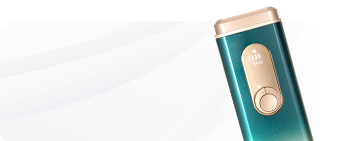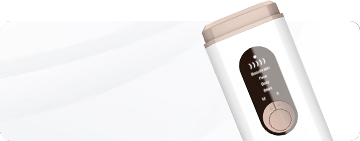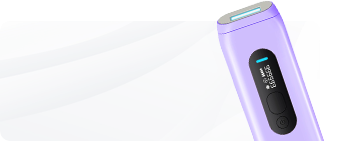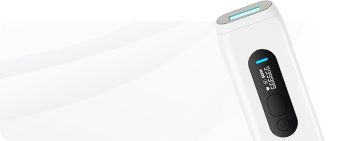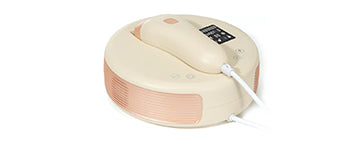Dealing with excessive hair growth from PCOS? It's harmless but disheartening if you prefer a smooth, hair-free look. Traditional hair removal can be irritating and offers only temporary fixes. However, choosing the proper method can permanently reduce hair without discomfort or damage to your skin.
What is polycystic ovary syndrome (PCOS)?
Polycystic ovary syndrome (PCOS) affects about 6 to 12 percent of women and can lead to a variety of symptoms. Women with PCOS often experience irregular periods, signs of high male hormones like acne and excess body hair, and might see their ovaries filled with small cysts on an ultrasound. It's common for women with PCOS to be overweight or obese, and they face a higher risk of conditions like sleep apnea, type 2 diabetes, fatty liver disease, and depression. For those looking to become pregnant, fertility treatments may be necessary to help with ovulation.
Why does PCOS cause hirsutism?
Hirsutism is when women grow thick, dark hair in areas where it usually doesn't appear, such as the chest, face, lower abdomen, upper legs, and back. This indicates higher than normal levels of male hormones, known as androgens. Polycystic ovary syndrome (PCOS) is a common cause of this condition; it involves the ovaries producing excessive androgens, which can lead to problems like too much hair growth, irregular menstrual cycles, and fertility issues.
How do you remove excessive hair?
Laser hair removal (including IPL) and electrolysis can permanently remove hair for those with PCOS. Keeping your hormone and insulin levels in check is crucial for the best results. Managing these levels through appropriate treatments can help prevent new hair growth, making these hair removal methods more effective.
Does IPL hair removal work for hirsutism in PCOS? Many women see a 30-40% reduction after 4-6 treatments, with further improvement after more sessions.
- How it works
IPL hair removal uses Intense Pulsed Light to focus on the melanin in hair follicles. Once the light energy penetrates the skin, it transforms into heat, damaging the hair follicles and disrupting the hair growth cycle, preventing the hair from growing further.
- Why it's a great option for PCOS
- Long-lasting results: IPL Laser treatments target and damage hair follicles, greatly lowering the chances of hair growing back. While you may need a touch-up session every 12 to 24 months, the effects are almost permanent.
- Minimal hair visibility between sessions: IPL hair removal differs from Waxing because it requires you to shave beforehand, not grow your hair. This means you can keep your hair short and less visible between sessions. Actually, you need to shave before each treatment to prepare for the IPL.
- Less painful: IPL hair removal is generally less painful than other hair removal methods. Depending on the person and the device used, the sensation can range from no pain at all to a snap like a rubber band.
- Safe: At-home IPL hair removal devices like the Naisigoo The Shiner are generally safe when used properly. It is important to follow the instructions carefully, and it's reassuring to know that this device is certified safe and verified by dermatologists.
- Potential drawbacks
- Hormone management: Effective IPL treatments require managing your PCOS with medication. Without controlling hormones through contraceptives or drugs like metformin, results may be limited.
- Hair and skin type: These treatments are less effective for light hair or very dark skin, as the laser struggles to target the follicles. However, alternative options are available.
*Expected maintenance: 4-6 initial sessions
*Average session length: 15-60 minutes
*Long-term results: Yes
*Pain level: low
2.Electrolysis:
This method uses a small needle and an electric shock to individually target and destroy each hair root. It's not ideal for large areas since every hair follicle needs attention. Side effects may include slight skin discoloration (red, purple, or brown), temporary dark spots, and a sharp sting.
*Expected maintenance: 10-14 total treatments
*Average session length: 15-60 minutes
*Long-term results: Yes
*Pain level: high
It offers a long-lasting solution for unwanted hair, performed in a clinic by professionals. This method targets dark hair follicles with laser precision, unlike broader IPL treatments suitable for home use. It's effective for PCOS hair but costly, requiring multiple sessions that can total hundreds of dollars each. If you're prepared for the expense and clinic visits, it provides excellent results.
*Expected maintenance: 6-8 initial sessions
*Average session length: 15-60 minutes
*Long-term results: Yes
*Pain level: moderate
Other hair removal methods for PCOS:
- Weight loss
Losing weight is often the first step in treating hirsutism. Losing just 5% of your body weight can help lower male hormone levels and reduce excessive hair growth.
- Shaving
It's the most common way to remove hair. It's quick and straightforward, but you need to shave frequently to keep stubble at bay. Watch out for possible cuts and ingrown hairs.
*Expected maintenance: 2 times/week
*Average session length: 15 minutes
*Long-term results: No
*Pain level: low
- Waxing
Waxing is a widely used method to remove PCOS hair by pulling it out from the roots with sticky wax. You can opt for professional services or use DIY wax strips for small areas. Remember that Waxing requires regular sessions and can be painful, especially on sensitive skin. The results, however, can keep your skin smooth for several weeks.
*Expected maintenance: every 3-6 weeks
*Average session length: 10-30 minutes
*Long-term results: No
*Pain level: moderate
- Tweezing
If you're precise and have spare time, tweezing might suit you. It involves plucking hairs individually, which is ideal for small areas but less practical for extensive facial hair due to PCOS. Tweezing works well for eyebrows or catching missed hairs, although it's not the best for sensitive skin. The effects can last a few weeks.
*Expected maintenance: weekly
*Average session length: 5-15 minutes
*Long-term results: No
*Pain level: low
- Hair removal creams
Quick and convenient, hair removal creams can easily tackle PCOS facial hair: just spread on, wait a bit, and wash away the hair. They work on surface hair, and regrowth can happen quickly, often in a day. Be mindful of the skin irritation they may cause and opt for creams designed for facial use.
*Expected maintenance: 2 times/week
*Average session length: 5-10 minutes
*Long-term results: No
*Pain level: low
- Epilating
Epilating offers a handy at-home solution for managing PCOS facial hair. It's a small device that plucks hair out. It can sting as it pulls hair from the roots, but the smoothness lasts weeks, which is longer than shaving. Just wait for the hair to grow a bit before reusing it.
*Expected maintenance: every 3 to 4 weeks
*Average session length: 15 to 30 minutes
*Long-term results: No
*Pain level: moderate
- Threading
Threading is a traditional method to temporarily manage PCOS facial hair, using cotton threads to pull hairs from the roots. It's best done by a professional due to its tricky technique. This quick and affordable method is less painful than others, with smooth results lasting several weeks.
*Expected maintenance: every 2 to 4 weeks
*Average session length: 5 to 15 minutes
*Long-term results: No
*Pain level: low
- Medications
If you're experiencing hirsutism from PCOS, treatments like medication can help reduce androgen levels and manage symptoms. Options include birth control, androgen blockers, and low-dose steroids. These won't eliminate facial hair completely but can reduce and improve other PCOS symptoms. Discuss with your doctor whether medication is suitable for you.
Say goodbye to unwanted hair!
We understand how challenging life with PCOS can be, with many things feeling beyond your control. Fortunately, removing unwanted hair is something you can manage.
We hope this information helps you decide how to tackle unwanted facial and body hair. Here's to achieving smoother skin!
